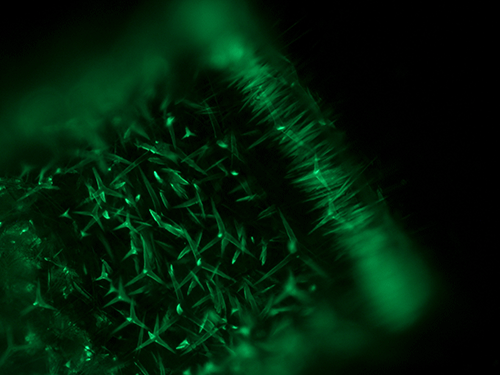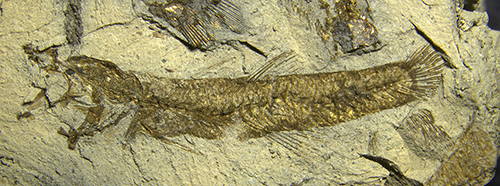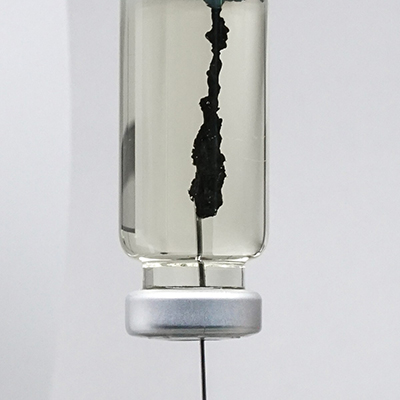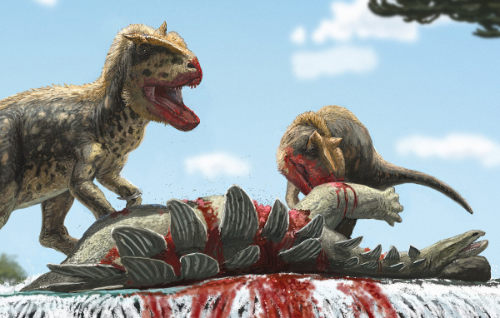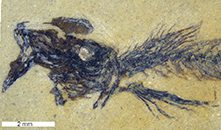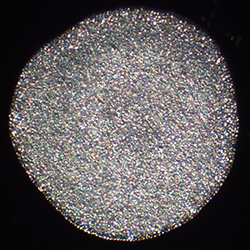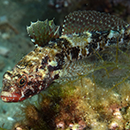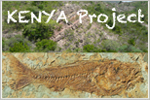News & Infos
-
27.06.2023
Glass sponge genome furnishes insights into evolution of biomineralization
The genome of a glass sponge species suggests that silica skeletons evolved independently in several groups of sponges. more
-
11.04.2023
Prof. Dr. Manuel Aranda
Manuel Aranda is a Visiting Fellow at CAS in April and May 2023 at the invitation of Prof. Dr. Gert Wörheide (Palaeontology and Geobiology). more
-
11.11.2022
Crown-of-thorns seastar from Red Sea
LMU and SNSB researchers have identified coral-eating crown-of-thorns seastars in the Red Sea as distinct species that occurs only in this location. more
-
09.08.2022 at 00:00
MGAP student Andrea Herbert Mainero receives LMU-Research award for excellent students
MGAP student Andrea Herbert Mainero receives LMU-Research award for excellent students more
-
11.07.2022
Paleobiology: complex family relationships
An international team of researchers led by LMU paleontologist Bettina Reichenbacher has managed to classify fossils of one of the most species-rich fish groups into a family tree for the first time. more
-
12.01.2022
Low CO2 concentrations
The team led by LMU researcher Sebastian Höhna reports in Nature Communications. more
-
10.01.2022
ERC Starting Grant awarded to Dr. Sebastian Höhn
Dr. Sebastian Höhna is one of four receipents at LMU of a prestigeous Starting Grant of the European Research Council (ERC). more
-
19.11.2021
Climate change: Independent stress response makes octocorals more robust
LMU scientists have identified mechanisms that make octocorals less sensitive to the effects of climate change than other kinds of coral. more
-
17.09.2021
Deep-sea biodiversity off New Zealand higher than assumed
During a research cruise off the coast of New Zealand, a team led by LMU geobiologist Gert Wörheide discovered six new species of glass sponge. more
-
17.08.2021
Microbiology: Bacterial evolution in ancient sub-seafloor sediments
Micro-organisms persisting deep below the seafloor for millions of years continue to evolve despite living at the energy limit to life. more
-
15.02.2021
All eyes on the oceans
The UN's Decade of Ocean Science for Sustainable Development formally opens on February 15. In the following interview, Professor Gert Wörheide tells us why the oceans urgently need more attention. more
-
27.01.2021
Bones reveal the secret of the exceptional long neck in giraffes
In collaboration with researchers from the Humboldt-Universität zu Berlin, LMU-palaebiologist Christine Böhmer found support for a one-hundred-year-old hypothesis regarding the evolution of the giraffe’s long neck. In collaboration with researchers from the Humboldt-Universität zu Berlin, LMU-palaebiologist Christine Böhmer found support for a one-hundred-year-old hypothesis regarding the evolution of the giraffe’s long neck. more
-
18.11.2020
Some like it hot: Global warming triggered the evolution of giant dinosaurs
An international team of scientists found evidence that a rapid climate change some 180 million years ago probably triggered the evolution of the famous long-necked dinosaur giants. Their results were now published in the prestigious scientific journal „Proceedings of the Royal Society of Lon-don“. more
-
26.10.2020
Sponges as biomonitors of micropollution
Sponges are filter feeders that live on particulate matter – but they can also ingest microscopic fragments of plastics and other pollutants of anthropogenic origin. They can therefore serve as useful bioindicators of the health of marine ecosystems. more
-
16.09.2020
The oldest known sperm cells
An international team of paleontologists has discovered giant sperm cells in a 100-million year-old female ostracod preserved in a sample of amber. Clearly, the tiny crustacean had mated shortly before being entombed in a drop of tree resin.Das internationale Team rekonstruierte eine bislang unbekannte Krebstierart, die die Forscher Myanmarcypris hui nannten. more
-
23.07.2020
Survive below the seafloor
Foraminifera, an ancient and ecologically highly successful group of marine organisms, are found on and below the seafloor. LMU geobiologists report that several species not only survive, but thrive, in these oxygen-free sediments. more
-
01.07.2020
A new dinosaur from Canton Schaffhausen – ancestor of the giants
An international team of palaeontologists recently described a new dinosaur from Canton Schaffhausen under the name Schleitheimia schutzi in the Swiss Journal of Geosciences. The actual study is based on older finds of a local collector and new fossils from an excavation in 2016. Schleitheimia lived about 210 million years ago in the early time of the dinosaurs and is - following the scientists - part of the origin of the sauropods. This is the group of reptiles that evolved into the long-necked giants, known today as typical dinosaurs by everybody. more
-
08.01.2020
Revelatory relationship
A new study of the ecology of an enigmatic group of novel unicellular organisms by LMU scientists supports the idea hydrogen played an important role in the evolution of Eukaryota, the first nucleated cells. more
-
18.09.2019
Team Munich did exceptionally well at the 90th Annual Conference of the Paläontologische Gesellschaft:
-
15.07.2019
New light on cichlid evolution in Africa
-
07.07.2019
Professor Wörheide elected into the Academia Europaea
-
14.05.2019
Archaeopteryx gets company
Researchers at LMU Munich describe a hitherto unknown bird from the late Jurassic period. It is the second bird capable of flight, after the famous Archaeopteryx, to be identified from this era. more
-
28.02.2019
Diversification after mass extinction
A team led by LMU paleontologist Adriana López-Arbarello has identified three hitherto unknown fossil fish species in the Swiss Alps, which provide new insights into the diversification of the genus Eosemionotus. more
-
11.02.2019
Larger datasets unravel deep roots
Comparative genome content analyses provide insight into the early evolution of animals. A novel method that permits the use of larger datasets in such studies yields results that are consistent with classical views of animal phylogeny. more
-
28.01.2019
Plants resisted the worst mass extinction
The great mass extinction around 250 million years ago affected plants much less than animals. An article with this conclusion by Evelyn Kustatscher and Hendrik Nowak from the Museum of Nature South Tyrol together with Elke Schneebeli-Hermann from the University of Zurich is published today in the renowned scientific journal Nature Communications. more
-
10.12.2018
Ancient lake deep drilling allows for fresh look at theory of island biogeography
Speaker: Prof. Thomas Wilke (Justus Liebig University Gießen) more
-
19.11.2018
Climate change and cultural collapse
An analysis of ancient DNA recovered from sediments in the Arabian Sea suggests that climate changes that set in some 4000 years ago may have triggered the collapse of the early urban civilization in the Indus valley. more
-
20.08.2018
Coral Reefs – Endangered oases of the oceans
-
01.08.2018 at 00:00
Outwardly identical, yet distinct
All placozoans are superficially identical. But comparative genomic data reported by an LMU team reveals the presence of different genera. This is the first time that a new animal genus has been defined solely by genomics. more
-
06.06.2018
Unusual honor for LMU geobiologists
A taxonomic study of Red Sea and Western Indian Ocean calcareous sponges has led to the recognition of 16 species new to science. Three of those have now been named in honor of LMU researchers. more
-
21.03.2018
Adaptive radiations in the Mesozoic
Bony fishes are the most diverse of all extant vertebrate groups. A comprehensive phylogenetic analysis of the group now provides new insights into its 250-million-year evolutionary history. more
-
21.02.2018
5th Young Reef Scientists Meeting
We are pleased to announce that the 5th edition of the Young Reef Scientists Meeting will be held at Ludwig-Maximilians-University in Munich (Germany) from the 5th to the 7th of September 2018. more
-
06.02.2018
Sponges can economize on oxygen use
Sponges lack a signaling pathway that responds to low intracellular oxygen levels in more complex animals. Do they use a different mechanism for this purpose or did their earliest ancestors evolve at a time when less oxygen was available? more
-
05.02.2018
International Year of the Reef
On 28 January, the International Year of the Reef (IYOR 2018) was officially launched in Germany at boot Düsseldorf, the world's largest water sports trade fair. This global initiative, first launched in 1997, is now taking place for the third time. more
-
29.01.2018
The eleventh Archaeopteryx
LMU researchers report the first description of the geologically oldest fossil securely attributable to the genus Archaeopteryx, and provide a new diagnostic key for differentiating bird-like dinosaurs from their closest relatives. more
-
04.12.2017
In the beginning there was the sponge
Which group of animals evolved first? This problem has become a bone of contention among biologists. An international research team is now confident that the definitive answer is at hand: Sponges appeared before comb jellies. more
-
25.10.2017
Scavenging to survive below the seafloor
Microorganisms living in the sediments buried below the seafloor obtain their nutrients by using secreted enzymes to degrade adsorbed detritus. A new study shows that in order to survive for long time scales, microorganisms eat one another after they die. more
-
20.09.2017
Lumbering giants had agile ancestors
The best known sauropod dinosaurs were huge herbivorous creatures, whose brain structures were markedly different from those of their evolutionary predecessors, for the earliest representatives of the group were small, lithe carnivores. more
-
07.08.2017
Hidden witnesses to climate history
They once inhabited the seafloor and have been steadily buried: Microorganisms in the sub-surface sediments at the bottom of the Arabian Sea reveal details of fluctuations in climate and environmental conditions over the past 52,000 years. more
-
16.06.2017
Hot start, followed by cold shock
The initial phases of animal evolution proceeded faster than hitherto supposed: New analyses suggest that the first animal phyla emerged in rapid succession – prior to the global Ice Age that set in around 700 million years ago. more
-
14.06.2017
Exploring invertebrate genomes
A new EU-funded project will explore the diversity and architectures of genomes found in invertebrate animals, and promises to enhance our knowledge of their ecological and evolutionary importance, as well as their biotechnological potential. more
-
02.05.2017
On mosaics and melting-pots
Genetic studies of cichlid fishes suggest that interspecies hybrids played a prominent role in their evolution. Analysis of a unique fossil cichlid from the Upper Miocene of East Africa now provides further support for this idea. more
-
21.12.2016
The origin of antlers
A new study shows that deer species capable of building and shedding their antlers already existed about 20 to 15 million years ago, in the Miocene. The finding sheds new light on the evolution of deer. more
-
31.08.2016
A monster put in its place
An analysis of the fossil known as the Minden Monster has enabled paleontologists to assign the largest predatory dinosaur ever found in Germany to a previously unknown genus, among a group that underwent rapid diversification in the Middle Jurassic. more
-
08.08.2016
Ancient DNA reveals novel relationships
LMU researchers have sequenced mitochondrial DNA from museum specimens of rare species of deer. Analysis of partial nucleotide sequences has enabled the team to refine our picture of the evolutionary history of cervids. more
-
19.07.2016 at 21:00
Aftermath of a mass extinction
A new study of fossil fishes from Middle Triassic sediments on the shores of Lake Lugano provides new insights into the recovery of biodiversity following the great mass extinction event at the Permo-Triassic boundary 250 million years ago. more
-
04.05.2016
The evolution of development
On the basis of an analysis of 520 million-year-old fossils, LMU researchers show that embryonic and larval development in the early ancestors of spiders and scorpions was strikingly and unexpectedly similar to that of modern crabs. more
-
13.01.2016
Ash-falls blighted the grasslands
LMU paleontologists have used data derived from new fish-fossil finds, pollen analyses and sedimentology to reconstruct the environmental conditions that prevailed in Africa’s Rift Valley in the Middle to Late Miocene Era. more
-
13.01.2016
Unique biodiversity - from top to bottom
Living fossils, rare corals and sponges: The depths of the Coral Sea off the northeast coast of Australia harbor unique and hitherto undiscovered biological communities. more
-
30.11.2015
Revolution averted
Who came first – sponges or comb jellies? A new study by an LMU team reaffirms that sponges are the oldest animal phylum – and restores the classical view of early animal evolution, which recent molecular analyses had challenged. more
-
17.09.2015
Hox genes provide a backward look
A study of the embryonic development of the Nile crocodile’s axial skeleton reported by LMU paleontologists sheds new light on a phase of vertebrate evolution that dates back hundreds of millions of years. more
-
30.06.2015
DNA barcoding discloses diversity
LMU-Wissenschaftler haben DNA-Erkennungssequenzen antarktischer Schwämme analysiert und neue Einblicke in deren Artenvielfalt und Evolutionsgeschichte erhalten. more
-
17.06.2015
The long reach of the Hox code
LMU researchers have shown that patterns of activity of certain genes in vertebrate embryos correlate with differences in the length of the neck region. The findings also provide new insight into the evolution of long-necked dinosaurs. more
-
05.05.2015
Unique fish fossils identified
An LMU team has identified the first fossil specimens of a major group of killifishes that is widely distributed in freshwater habitats today. The 6-million-year-old material sheds new light on the evolution of the bony fishes. more
-
04.05.2015
The secrets of the brachiopod shell
LMU researchers have carried out the first detailed study of the molecular mechanisms responsible for formation of the brachiopod shell. Comparison with shell synthesis in other groups reveals the deep evolutionary roots of the process. more
-
23.03.2015
Deciphering the genomes of invertebrates
LMU is hosting a 3-day international workshop on the Genomics of Invertebrates next week. The meeting begins on Sunday March 22nd. more
-
12.01.2015
Evolution - Rock sponges split up
A study led by LMU researchers throws new light on the evolution of the so-called rock sponges, and reveals that conventional, morphology-based taxonomies do not accurately reflect the true genealogical relationships within the group. more
-
24.11.2014
Stone chronicles
The first detailed study of the otoliths of extant African annual killifish species provides vital information that will facilitate the identification of fossil forms of this group and contribute to the elucidation of their evolutionary history. more
-
02.07.2014
First show-off, then take-off
LMU paleontologists are currently studying a new specimen of Archaeopteryx, which reveals previously unknown features of the plumage. The initial findings shed light on the original function of feathers and their recruitment for flight. more
-
14.05.2014
Exceptional preservation of ancient sperm in Miocene ostracods from the Riversleigh fossil deposits (Queensland, Australia)
Since the discovery of ostracods’ giant sperm in the mid 1800s, their function and evolution have remained enigmatic, in part because of a lack of fossil data. A study on an Australian Miocene ostracod fauna – carried out by LMU researcher Renate Matzke-Karasz and an international team – now sheds light on the evolution of this opulent way of reproduction. more
-
04.06.2013
The eloquence of the otoliths
Fish fossils that are about 23 million years old give unprecedented insight into the evolutionary history of the gobioid order, one of the most species-rich groups among the modern bony fishes. more
-
14.03.2013
Trove of fish fossils discovered
A research team led by LMU paleontologist Bettina Reichenbacher has uncovered a rich trove of fossil fish in the Rift Valley in Kenya. The new specimens promise to reveal important details of the evolutionary history of freshwater fish in Africa. more
-
08.10.2012
The riddle of the mystery gazelle
From chimera to species: Museum specimens obtained nearly 200 years ago represent the only evidence for an enigmatic species of Arabian gazelle. Closer examination of the material has now led to a different, and very surprising, conclusion. more
-
04.07.2012
The genetic way to identify sponges
Sponges are an ancient phylum of animals found in marine and freshwater habitats, and their systematic classification poses many problems for zoologists. A new archive of DNA sequences promises to make the task far less taxing for taxonomists. more
-
03.07.2012
Downy dinosaur discovered
The new fossil find from the chalk beds of the Franconian Jura evokes associations with a pet cemetery, for the young predatory dinosaur reveals clear traces of fluffy plumage. It also poses an intriguing question: Were all dinosaurs dressed in down? more
-
26.06.2012
Fit as a sponge
Sponges - a very old evolutionary lineage - lack true muscles but still have some proteins typically found in muscle cells. These new findings suggest that the origins of musculature lie much further back in time than suspected. more
-
02.05.2012
Dinosaurs indecline long before mass extinction?
Despite years of intensive research about the extinction of non-avian dinosaurs about 65.5 million years ago, a fundamental question remains: were dinosaurs already undergoing a long-term decline before an asteroid hit at the end of the Cretaceous? A study led by scientists at the American Museum of Natural History (AMNH)and LMU Munich gives a multifaceted answer. more
-
06.02.2012
Mycorrhizal root nodules in a Triassic conifer
-
16.03.2011
Resolving Difficult Phylogenetic Questions: Why More Sequences Are Not Enough
-
08.08.2010
New special exhibition "Teeth"
-
05.08.2010
Annual Meeting of the German Palaeontological Society in Munich
-
27.05.2010
Horned dinosaurs also lived in Europe
-
01.05.2010
New Humboldt-Fellows at the Chair of Palaeontology & Geobiology
-
31.03.2010
Media impact of "Deep Down Under"
-
24.11.2009
Blogging from deep down under
Hunting for living fossils in the deep sea more
-
01.10.2009
Oldest hominid skeleton unveiled
LMU researcher Ioannis Giaourtsakis studies Ardipithecus’ environment more
-
05.08.2009
Chicken-hearted tyrants
Predatory dinosaurs as baby killers more
-
23.07.2009 – 31.05.2010
Tracing Evolution
Special Exhibition in the im Palaeontological Museum Munich more
-
18.06.2009
Size did matter
Evidence of giant sperm found in microfossils more
-
04.05.2009 at 10:00
Third CORE Mini-Symposium
-
20.04.2009
Bachelor Meeting 2009
Information about Summer Term 2009 more
-
02.04.2009
Early family ties
No sponge in the human family tree more
-
12.02.2009
Academic and Student Exchange Agreement signed with South Valley University (Egypt)
-
10.12.2008
Starfish really a gang of four
-
20.11.2008
Beyond corals and fish: the effects of climate change on noncoral benthic invertebrates of tropical reefs


